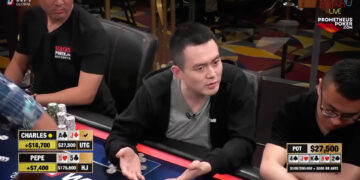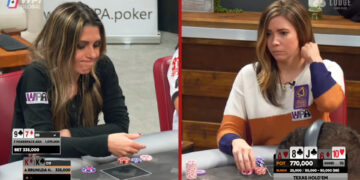When you first learn how to play poker, you’re going to focus on the poker basics. You’ll learn simple poker rules and how to deal with your own poker hand. Just concentrating on this is going to make you better than at least half of the players at any given table.
If you want to get really good at Texas Hold’em poker and learn how to play in poker tournaments, though, learning about poker rules and poker hands isn’t enough. You’re going to have to graduate beyond the fundamentals and learn a few poker plays.
There are honestly as many poker plays as there are poker tournaments, but we are just going to focus on four that are quite exciting. These four poker plays are going to help you to win more poker hands and eventually help you to master the art of Texas Hold’em Poker.
Poker Plays #1: The Stop and Go

This is one of those very simple poker players that’s going to change your poker strategy for the better. All you need to do is bet and then see what comes.
Technically, the stop and go is a poker play that relies on two things – position and your intent. You won’t be in position when you bet on this play, and you need to intend to go big when no matter what you see on the flop.
This is, however, one of those poker plays that you don’t see in a ton of poker games. You mostly see it in poker tournaments, and for good reason – you’re going after money, and you’re going to use it when you probably don’t have enough chips to be playing any other way, basically short stacks.
Now, your goal here isn’t to go in and win. Your goal is to get your opponent to fold a hand that he would have called if you had actually put in your chips before the flop. It’s trickery to be sure, but the kind of trickery that defines poker strategy.
If you want to do this right, you’re going to need to learn how to pull off every piece correctly. In order to perfect this poker strategy, we’re going to look at a hypothetical situation.
In this hypothetical, you’re sitting at the big blind and you hold reasonable hand – Ace/Jack. It’s not the kind of hand that’s always a winner, but it’s fine. The player on the button raises, so you need to choose what to do next.
If the small blind decides to go out in front of you, you’re going to have to decide between calling, folding, or going all in.
Now, calling is usually not a preferred strategy, but it works here. If you went all-in, the player on the button would pretty much have to call based on the pot odds. In fact, most players in that position are already waiting to pounce on you if you raise.
Since you’ve got fairly rough odds here, your best chance to win is to take the pot from the other players rather than going to a showdown. You won’t get that by going all-in before the flop, so you’re going to have to do it later.
Stop and go is so-named because you’re going to stop the play with your call, and then go again with your all-in bet no matter what comes out on the flop. When you go all-in after the flop, you suddenly seem like you’ve hit something good – and the other player suddenly has a much worse range in front of him or her than before.
In this case, a lot of hands have suddenly become very unattractive to the other player. A small pair, for example, now looks pretty rough because any of the overcards on the table now look like they are part of a potential pair or flop.
If the other player had a good hand of connectors and the flop came out with something that’s not quite building a straight, he’s also going to want to throw away his cards – he might be working on nothing while you have everything.
When you chose to call before the flop, you allowed the other player to get complacent. Now that you’re moving again, you’re going to scare off an awful lot of players and take pots that you don’t deserve to win.
By just calling before the flop you not only stand a better chance of winning the pot uncontested, you force your opponent into tough spots where they can make mistakes.
Poker Plays #2: Push-Fold

This is another one of those poker strategies that reduce your number of moves so that you can better control the table. It’s among the more popular poker plays because it tends to work extremely well.
What you’re doing here is kind of tricky, and even a bit counter-intuitive. You’re pushing – going all-in or folding at the right time. You’re allowing yourself to pick up a ton of blinds and antes, but you’re also making it count when you double up.
Honestly, the strategy is poker at its simplest. You’re either pushing or you are folding. That’s it. No other fancy poker players. Just those two options.
Again, this is a small short stack strategy. Since you’ve got too little in front of you to be clever, you need to be brutal. You’re in or you’re out.
Not bad, right?
Now, a poker strategy that is this simple can also be exceptionally stupid. As such, you’re going to have to learn how to do this correctly.
The first thing you have to understand is the philosophical underpinnings of going all-in. All-in is not the same thing as raising. All-in is, in short, being incredibly gutsy because you have the chance of going out.
In our hypothetical for this one, you’re sitting at a very short stack and you three-bet. Do you know what you just did? In most cases, you just invited other players to call, which is going to hurt. If you had gone all-in, you would’ve taken the blinds at the very least.
What this means in most cases, though, is that you only get to play the big hands. If you don’t know that you can survive all-in, you can bide your time.
You are also going to be focusing on making your double-ups really count. The vast majority of the time, you’re going to greedily gobble up all of those blinds and antes in order to raise the size of your stack.
At some point, your opponents are going to cotton to this strategy and start getting aggressive. You’re going to do the same thing, eventually. You just need to get your timing right.
So, how do you know when to go all in?
First, you’re going to look at position. If you’re not the first to move, you better have a premium hand. Next, the range of hands that you can use here is going to change significantly based on your position.
From there, you’re going to look at the people against whom you are playing. If there are loose players in the blinds, you need to get tight. If the tight players are there, though, you’re going to get loose.
Poker Plays #3: The Re-Steal

This is a fun bit of poker strategy. After all, who doesn’t like to take something back from an opponent?
This is very much a tournament strategy, because it counts on the fact that other players are playing reasonably well. They’re raising in late positions to steal the blinds, and you’re going to have to figure out when it’s okay to steal those chips back.
Your goal here is to know the other players well. If a loose and aggressive player has raised just to yank away the blinds, you need to three-bet. This allows you to capitalize on the fact that their hand isn’t as good as what they’ve advertised.
As always, we’re going to talk about how to make this one of the smart poker plays before we move on.
You have to be aware that you’re bluffing when you do this. You are only re-stealing because you think that you don’t have a winner. If you’re three-betting because you have a good hand, you’re not re-stealing anything – you’re just playing good poker.
Your goal here is to make the other player fold to you so that you can capture some blinds. You want to look at the other player and get in his head to figure out how you can make him throw away his cards when he’s already raised.
The best way to get away with this is to start by looking at good players. Only successful players can successfully steal, so find those who are playing good poker to mark your victim.
These players usually go with the standard loose-aggressive playstyle. They’re not crazy, but they use wide ranges and know how to play what is in front of them. Your ideal mark is the guy who is willing to fold after raising to preserve his stacks.
By the way, the type of player you are matters here as well. You need to have the image of a tight, reliable player who knows what he’s doing. Being tight helps, because it’s going to convince the other player that you’ve got something good. You can’t be the guy bluffing every hand because that’s just going to invite more calls and raises.
There are some other factors to keep in mind here as well. Your position always matters no matter what you’re doing, so try to time your re-steals when you’re on the button or cut-off. This allows you to push others out of position and be a little more of a bully.
The forgotten factor here does tend to be your own hand, though. You do still need something reasonably useful even though you are bluffing. You can and will get called from time to time, and you need to be able to ride out what’s going on in the game.
Little pocket pairs are a great set of cards for a re-steal since you can figure out whether it’s going to be useful really quickly. If you screw up, that’s fine – get out of the hand and try again later.
Finally, you want to understand how to raise on this one. Because it’s a bluff, you’re going to have to raise by more than just a little. You have to bully the other guy out, and that means going bigger than you might like. Go for at least three times the bet of your opponent to really scare him off.
Poker Plays #4: The OverBet

The overbet is one of those lovely poker plays that many newbies luck into naturally. It’s a bully’s move and it’s simple, but that doesn’t mean that it doesn’t have a place at the table.
This is one of those poker plays you use when you know that your opponent can call a regular bet, but can’t match your stacks. It’s something you do late in the game because you’ve got more money than the other players.
Overbetting is, at its core, exactly what it sounds like. You’re betting way too much for the pot to scare off other players. You just need to figure out how to do it correctly.
The reason that newbies love this particular move is because it leads to some easy wins. The reason they tend to abandon it, though, is because it leads to some enormous losses.
Your goal is to figure out exactly how you’re going to use the move and what you’re hoping to get out of it. Typically, you’re either using it as a bluff or as manipulation.
The bluff move is one of the first poker plays that most people ever learn. They use big stacks to push other players away, and you’re going to do something similar. You’re just going to do it based on real information rather than gut instinct.
In this case, you’re looking at the hand strength, stack size, and tendencies of the other player at the table. You’re shooting to overbet when you think the other guy has a good but not great hand, because that’s when other people tend to get conservative.
Think about it in really basic terms. If the other player has the kind of hand that leads to big poker plays, he’s going to use it no matter how you bet. If he’s got a bad hand, he’s going to fold when you’ve put down anything reasonable. It’s only with the middle of the road hand that the overbet becomes a necessity.
Overbetting is, despite its use as a blunt-force tool, something that is often used to get value. You’ve got to know that it’s worth using at that specific time, otherwise you are simply committing too many resources to the endeavor. For one of the most basic poker plays, it’s also one that requires the most finesse.
Final Thoughts
These four poker plays need to become part of your arsenal. You can’t abandon the fundamentals, though. Think of these plays as hidden tools that you can use to supplement excellent, down-to-earth basics. See you at the WSOP!
♠ pokerjournal.org
Poker Plays – FAQ
What is a stop and go in poker?
Instead of shoving pre-flop with a short-stack in a tournament, you are calling pre-flop and then shoving on the flop no matter what hits the board. This intention is to make it look as though you hit the flop.
What does it mean to shove in poker?
A shove means to go all-in. This is also referred to as a jam.
When should you re-raise in poker?
You should re-raise when you think you have a better hand than your opponent. I recommend doing this with monsters as well because most players will expect you to slow-play a monster and won't see it coming.
What is an overbet in poker?
An overbet means you're betting more than is in the pot, sometimes a lot more. It confuses opponents and can look like a bluff. I like to use overbets with strong hands sometimes because my opponents will sometimes think it's a bluff.


















Discussion about this post